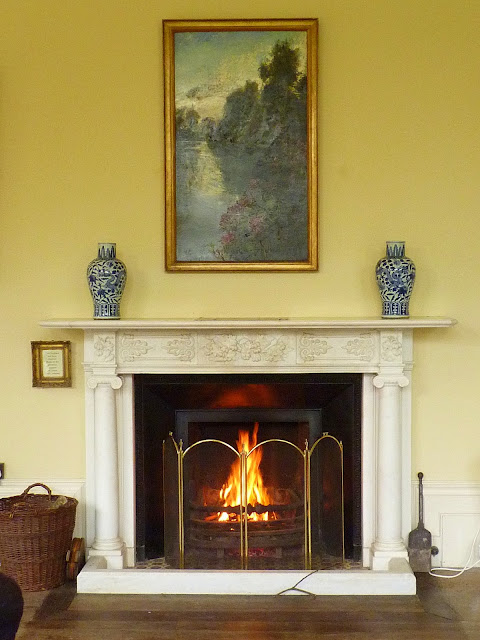The Ballroom’s floor boards below are 200 years old made from the
estate forest and being fitted together wonderfully with crafted knuckle joints.
In the reading room there was a wonderful black 3 panel screen with mother of pearl and beautiful bird decoration on it. Below I photographed a part of it with birds and foliage.
The room’s walls were decorated with 200 year old wallpaper
containing arsenic and cyanide so we didn’t touch them! It had birds, butterflies and flowers on it. Below is a close up of the wallpaper.
 |
| Close up of wallpaper |
After a super lunch at the Royal Hotel we went to Wellbrook
Beetling Mill. It dates from 1830 and is
the last water-powered linen beetling mill.
The guide started by showing us flax seed from which the linen is grown,
then taking us though all the processes until the beetling mill.
 |
| Flax Seed |
The function of a beetling mill is to form a smooth glossy
sheen on woven linen cloth. When the cloth first came to the mill it was wound
around a smooth wooden cylinder, these were actually tree trunks which had been
turned on a lathe. I hope you can zoom these 2 photos up to be able to read and understand the workings of the mill.
The cylinder is set in a wooden frame called a beetling
engine, directly above the cylinder are thirty two beetles, these are pieces of
wood usually beech and are about 4" square and about 5 Ft long, the
beetles are set side by side and are free to move vertically, protruding from
each of these about half way up is another piece of beech about 6" long.
In line with these at the same height as the wiper beam,
this is again a tree trunk with a steel shaft up the centre bolted to this and
arranged in a spiral are thirty two lifts, when the engine is started the wiper
beam turns lifting and dropping the beetles in succession, at the same time the
roller carrying the cloth turns but much more slowly. The cloth was beetled
like this for two or three days.
 |
| Beetling Mill |
This video below will show you the Beetling Mill in operation
After the cloth was finished it hung in the drying room above the engine house, before being folded for dispatch, linen was usually processed in bolts 23 yards long. It was fascinating and I hope you enjoy watching the video I took of the beetling machine working.
Thank you for visiting my blog and I hope the rain will
stop so I can get out to photo living nature!






the mill is pretty amazing!
ReplyDeleteYes it is amazing and the whole process of linen making before it got to the mill stage was fascinating.
DeleteThinking how old all that is, really brings home the craftsmanship of the time.
ReplyDeleteFascinating video.
Hi Keith Yes I wonder how many carpenter would make a joint like that! I never really knew the whole process of making linen. It was just a pity I could not put all the information in the post.
ReplyDeleteMargaret
Very good the photos of life in general. It is beautiful Margaret.
ReplyDeleteWow - I'm amazed by wallpaper that is 200 years old. Arsenic and cyanide? - good thing some things have changed!
ReplyDelete